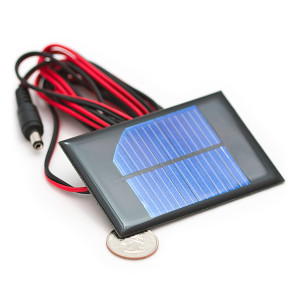
Solar Power your Arduino
You can download our e-book ‘Learn Arduino’ from this link
Solar panels or solar cells are becoming extremely popular as an alternative source of energy to power an Arduino. There are the 2 major setups which serve different purposes.
First, the Arduino board can be powered directly from a solar panel or a set of solar panels. Secondly, and the more robust approach is to install a battery pack along with the solar panels. The batteries are charged by the solar panels while the batteries provide reliable power to the circuit.
We’ll talk about the 2 methods but lets set the grounds straight first. Solar panels can be regarded as a source of energy like a battery with the exception that solar panels depends directly on sunlight. This does not only mean that during the night the solar panel won’t generate any power, it means that whenever the intensity of sunlight changes, the output power changes as well. Having said that, the choice of whether to add a battery pack or not should be easy. Basically, if a battery is used, the Arduino uses the power from the battery and the solar panel charges the battery when sunlight is available. The advantage of this setup is that your Arduino will keep running even on cloudy days, even during the night. An other less obvious advantage is that the output power is stable from the battery. No dips or spikes in power are felt by the Arduino.
Connecting the Arduino directly to the solar panel is probably undesirable, but possible still. In an environment where sunlight is abundant and downtime of the system is not an issue, battery-less solutions might be cheaper, simpler and smaller in size.
Choosing a solar panel is a difficult a tedious task. First of all you need to know up front your power requirements in volts and and amps. For example, lets say we need minimum of 5v, 100mA we need to use solar panels rated minimum at 7v, 150mA nominal. The panels will almost never reach nominal values, but in direct sunlight with an angle perpendicular to the Sun, the values will be very close. The battery (if any) has to be considered as well. Imagine having a 7.5v battery to power a 5v Arduino board. In this case although the board runs at 5v, we cannot use a solar panel rated 7v because we need to charge the battery. So a solar panel with higher voltage is chosen, for example 9v. Remember that different batteries require different protection circuits to be charged properly. So basically you cannot simply connect a battery directly to the solar panel/s.
Solar Panels come in different shapes and sizes, and power per square inch. An efficient solar panel is more attractive because it takes up less space for the same amount of power. In certain projects, flexible solar panels are ideal. They are normally very thin and very light rendering them the best option for aircraft and other light vessels.
Arduino is a very efficient device. In fact can run with as low as 25mA in normal conditions and with as little as 5mA on sleep mode. So this makes Arduino a perfect device for solar projects.

